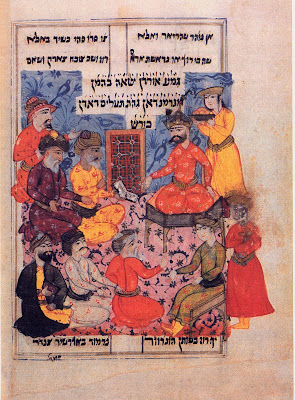By Karmel Melamed
09/21/05
It took Iranian Jews now living in the United States nearly three decades in exile from the land they called home for roughly 2,700 years to appreciate their rich history and culture preserved in their Judeo-Persian literature.
Considered one of the oldest yet least studied Jewish writings in the world by Jews, Judeo-Persian writings consist of the Persian language written in Hebrew characters by the Jews living in the countries modernly known as Iran, Afghanistan, Uzbekistan, and some parts of India during the last 1,000 years.
âIn Iran the Jewish community was not aware of the value of Judeo-Persian writings, but now that they are away from their home they feel more attached to their heritage and want to preserve it,â said Dr. Nahid Pirnazar, founder and director of the non-profit Los Angeles based House of Judeo-Persian Manuscripts foundation.
Pirnazar, who obtained her doctorate from UCLA in Iranian Studies with an emphasis in Judeo-Persian writing, said she formed the House of Judeo-Persian Manuscripts in 2000 after a significant number of Iranian Jews in Southern California expressed their interest in learning more about these ancient texts.
âThere are probably hundreds and hundreds of Judeo-Persian manuscripts in the possession of Iranian Jews,â said Pirnazar. âNot knowing what they are they think they are copies of Torahs,â said Pirnazar.
The Iranian Islamic revolution of 1979 sparked a mass exodus of Jews from Iran and today approximately 30,000 to 35,000 Iranian Jews now live in Southern California.
For the last seven years, Pirnazar said she has spent her own personal funds in addition to small donations from local Iranian Jews to acquire copies and even originals of Judeo-Persian manuscript collections owned by museums, libraries, and individuals in the U.S., Europe, Israel and Iran. Her ultimate objective is for the House of Judeo-Persian Manuscripts to become the primary location with the largest collection of Judeo-Persian works in the world.
âOur first goal is to collect and transliterate these manuscripts into the Persian script before the generation that can read them easily is gone,â said Pirnazar. âThe next step is to eventually publish and translate some into English and other languagesâ.
According to âPadyavandâ (Mazda Publishers, 1996), a series of books about Judeo-Iranian Studies by Professor Amnon Netzer of Hebrew University in Jerusalem, Judeo-Persian literature consists not only of Jewish biblical translations and commentaries but also secular poems, dictionaries, medical texts, scientific treatises, legends, calendars, and translations of works by the non-Jewish masters of classic Iranian literature.
The oldest Judeo-Persian manuscript which is coincidentally also the oldest Persian writing is a 37-line merchantâs letter dating back to the year 750 A.D. This letter was discovered in the early 20th century by archeologists in eastern Afghanistan, according to Padyavand.
Judeo-Persian came into being following the Arab-Islamic conquest of Persia in the 7th century when the Jews of Persia who spoke what is known as Middle Persian, refused to write the Persian language in Arabic letters but instead wrote Persian with the Hebrew letters they were familiar with, Pirnazar said.
âFrom a linguistic point of view Judeo-Persian has a significant value because it is the only accurate source where one can see the transformation or growth of the Persian language from the Middle Persian also known as Pahlavi to New Persian which was later influenced by Arabic vocabulary,â said Pirnazar. âThese Judeo-Persian manuscripts are the only written documents that have remained safe and untouched by scribes and show vowel sounds.â
Aside from their linguistic value, Judeo-Persian literature has also been a unique window into the previously unknown and painful history of Iranian Jews that lived under oppressive kings for centuries.
According to Vera Basch Moorenâs book, âIranian Jewryâs Hour of Peril and Heroismâ (American Academy for Jewish Research, 1987), the Iranian Jewish writer Babai Ibn Lutf chronicles in Judeo-Persian a seven year time span in the early 17th century when the Jews in the Iranian city of Isfahan were forced to convert to Islam or face being executed. Ultimately in 1629 the Jews of the city were permitted to return to Judaism after two of their leaders interceded on the communityâs behalf with the monarch Safi I of the Safavid dynasty.
Pirnazar also said Iranian Jews continued writing and reading Judeo-Persian up until the beginning of the 20th century but gradually drifted away from it as a result of the Alliance Israelite Universelle offering Iranian Jews western education in its schools based in Iran, the newly formed Iranian constitution permitted them to leave their ghettos and gain secular education, and the overall greater freedoms offered to Iranâs Jews during the Pahlavi dynasty.
While linguistic research of Judeo-Persian first began in the mid-19th century by Western scholars and has continued over the centuries, only within the last 40 years have very few Iranian Jewish scholars began their studies of Judeo-Persian.
Nearly five years ago the interest in Judeo-Persian was rekindled in the Southern California Iranian Jewish community after the Habib Levy Foundation in Los Angeles first began providing endowments for a class on Judeo-Persian that was initially taught by Netzer and is now taught by Pirnazar at UCLA.
âA lot of Iranian Jews still do not know that Judeo-Persian Studies exists,â said Tannaz Talasazan, a 21-year-old Iranian Jewish student at UCLA. âI think this course on Judeo-Persian is a great opportunity for young Jewish people, especially Iranian Jews who grew up here in America to learn more about who they are and where they came from.â
The UCLA course on Judeo-Persian has not only received tremendous praise from young Iranian Jews but also sparked the curiosity of some Iranian Muslim students wanting to learn more about a portion of Persian literature and poetry that had previously been unknown to them.
âBeing able to read Judeo-Persian script was certainly a feeling that I will never forget,â said Reza Khodadai, a 28-year-old veteran of the Iran-Iraq War and now biochemistry major at UCLA. âIt was at the final exam when I answered the whole transliteration section, I was reading a script that had always been unknown to me and I was seeing that it was actually in my own language of Persian.â
While universities in the U.S., Europe, and Iran with Iranian Studies programs have by in large not included Judeo-Persian courses in their programs over the years, many non-Jewish Iranian scholars have only now begun to recognize the impact Judeo-Persian literature has had to Iranâs history and language.
âI think what Nahid Pirnazar is doing is very important,â said Hossein Ziai, chair of UCLAâs Iranian Studies Program. âThis type of work will help larger audiences to realize how important an old symbolic relationship among Persians of all religious affiliations has been in Iranâs long history.â
Pirnazar said Judeo-Persian has attracted non-Jewish Iranians who want to discover new facts about their ancient civilization and likewise Ashkenazi Jews have been curious to learn about Jewish religious commentaries and literature that they have not been exposed to in the past.
âJudeo-Persian was not introduced to non-Jewish Iranians because it was written in Hebrew characters and it was not introduced to the world Jewry because it was in a language they did not know, so itâs interesting for both sides,â said Pirnazar. âSome types of Judeo-Persian are exact translations of the Torah and some other types include Iranian impute in them— thatâs the beauty of Judeo-Persian, itâs Iranian, Judaic, and Islamic cultural influences combined.â
Bijan Khallili an Iranian Jewish publisher and owner of the Los Angeles based Ketab Corporation, has been publishing a wide array of Iranian Jewish related books in both Persian and English for more than 20 years.
He said that while his company in 1999 published 3,000 Persian transliterated copies of a Judeo-Persian Torah commentary originally written by the 12th century Iranian Jewish writer âShahinâ, in the next few years he is also hoping to publish a Persian translation of a Judeo-Persian text written by the 15th century Iranian Jewish writer âEmraniâ.
âSales of the Shahin Torah were o.k., mostly older Iranian Jews can only read the book since it is in Persian,â said Khallili. âThe main problem is that younger people canât read Persian writing and they are the ones usually buying these books because they want to learn about their history, so we are looking to publish more of them in English.â
Currently the House of Judeo-Persian Manuscripts is looking transliterate the countless classic hand-painted Persian illustrations also known as âminiaturesâ that contain small excerpts written in Judeo-Persian. The organizationâs existing copies of Judeo-Persian manuscripts will soon be transferred to microfilm format for easier access by researchers, said Pirnazar.
âWe are looking for contributions to acquire more copies of manuscripts and to find older Iranian Jews who can read Judeo-Persian to help us transliterate because once that generation dies it will be very hard for scholars to do this type of transliteration,â said Pirnazar.
Karmel Melamed is an internationally published freelance journalist based in Southern California
This article was originally published by the Jewish Telegraphic Agency International Wire News service: http://www.jta.org/cgi-bin/iowa/news/article/Ancientlanguagecom.html
























 More news and opinions than at a Shabbat dinner, right in your inbox.
More news and opinions than at a Shabbat dinner, right in your inbox.